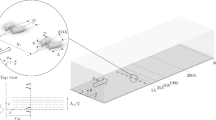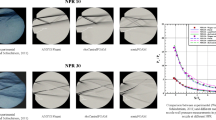Abstract
Predicting mixing parameters and mean concentration field of inclined negatively buoyant jets (INBJs) appropriately, has been a long-lasting challenge in numerical modeling of this type of jet flows. To address this challenge, 45\(^{\circ}\) inclined dense jets were simulated in OpenFOAM hiring three different approaches as Boussinesq-based and non-Boussinesq-based ones. The first approach was conducted by using a two-equation turbulence model, realizable k–\(\epsilon\) (RKE), in correlation with the standard gradient diffusion hypothesis (SGDH). In the second one, as the pure non-Boussinesq-based approach, turbulent scalar flux modeling (SFM), as an implicit second-moment closure-based approach, for the first time, was combined with the SSG turbulence model. Setting the model coefficients was conducted for both the SSG and SFM given that the calibration is a mutually coupled problem. The best agreement with the experimental data was found in approach two, where the return point dilution ratio, Sr/Fr, shows an increase about the 70%, 32%, 86% over their counterparts in approach one, the large eddy simulation (LES), and the standard k–\(\epsilon\), respectively. Quantitative comparisons for bulk parameters (geometrical and mixing) confirms that the SFM approach stands out with \(\sim 4\%\) average error while the corresponding value is \(\sim 19\%\) for the SGDH approach. These significant improvements over the prediction of mixing parameters can be perceived as the main benefit of the hired SFM approach. Evaluating the turbulent scalar flux vector was performed for both approaches, and it was shown that the SFM is more coordinated with the physics of the flow, compared to the SGDH, concerning the evolutionary behavior of the flow moving from the upstream to the downstream captured by the SFM. Regarding the LES simulations hiring high-performance computers and large quantities of grid numbers, the SFM can be regarded as the best RANS option to model the INBJs. This is the case, specifically, for the mixing parameters.



















Similar content being viewed by others
References
Mohammadian A, Gildeh HK, Nistor I (2020) CFD modeling of effluent discharges: a review of past numerical studies. Water 12(3):856
Papakonstantis IG, Christodoulou GC, Papanicolaou PN (2011) Inclined negatively buoyant jets 1: geometrical characteristics. J Hydraul Res 49(1):3–12
Lai CC, Lee JH (2012) Mixing of inclined dense jets in stationary ambient. J Hydro-environ Res 6(1):9–28
Fischer HB, List JE, Koh CR, Imberger J, Brooks NH (1979) Mixing in inland and coastal waters. Academic, New York
Roberts PJ, Salas HJ, Reiff FM, Libhaber M, Labbe A, Thomson JC (2010) Marine wastewater outfalls and treatment systems. IWA Publishing, London
Roberts PJ, Ferrier A, Daviero G (1997) Mixing in inclined dense jets. J Hydraul Eng 123(8):693–699
Zeitoun M, Reid R, McHilhenny W, Mitchell T (1972) Model studies of outfall systems for desalination plants. Office of Saline Water, US Department of the Interior, Washington, DC
Roberts PJ, Toms G (1987) Inclined dense jets in flowing current. J Hydraul Eng 113(3):323–340
Cipollina A, Brucato A, Grisafi F, Nicosia S (2005) Bench-scale investigation of inclined dense jets. J Hydraul Eng 131(11):1017–1022
Kikkert GA, Davidson M, Nokes R (2007) Inclined negatively buoyant discharges. J Hydraul Eng 133(5):545–554
Shao D, Law AWK (2010) Mixing and boundary interactions of 30 and 45 inclined dense jets. Environ Fluid Mech 10(5):521–553
Shao D (2010) Desalination discharge in shallow coastal waters. PhD Thesis, Nanyang Technological University
Zhang W, Zhu DZ (2010) Near-field mixing downstream of a multiport diffuser in a shallow river. J Environ Eng 137(4):230–240
Papakonstantis IG, Christodoulou GC, Papanicolaou PN (2011) Inclined negatively buoyant jets 2: concentration measurements. J Hydraul Res 49(1):13–22
Oliver C, Davidson M, Nokes R (2013) Removing the boundary influence on negatively buoyant jets. Environ Fluid Mech 13(6):625–648
Jiang B, Law AWK, Lee JHW (2013) Mixing of 30 and 45 inclined dense jets in shallow coastal waters. J Hydraul Eng 140(3):241–253
Abessi O, Roberts PJ (2015) Effect of nozzle orientation on dense jets in stagnant environments. J Hydraul Eng 141(8):06015009
Abessi O, Roberts PJ (2015) Dense jet discharges in shallow water. J Hydraul Eng 142(1):04015033
Crowe A, Davidson M, Nokes R (2016) Velocity measurements in inclined negatively buoyant jets. Environ Fluid Mech 16(3):503–520
Papakonstantis IG, Tsatsara EI (2018) Trajectory characteristics of inclined turbulent dense jets. Environ Process 5(3):539–554
Papakonstantis IG, Tsatsara EI (2019) Mixing characteristics of inclined turbulent dense jets. Environ Process. https://doi.org/10.1007/s40710-019-00359-w
Jiang M, Law AWK, Song J (2019) Mixing characteristics of inclined dense jets with different nozzle geometries. J Hydro-environ Res 27:116–128
Vafeiadou P, Papakonstantis I, Christodoulou G (2005) Numerical simulation of inclined negatively buoyant jets. In: The 9th international conference on environmental science and technology, September 2005, pp 1–3
Oliver C, Davidson M, Nokes R (2008) k–\(\varepsilon\) Predictions of the initial mixing of desalination discharges. Environ Fluid Mech 8(5–6):617
Kheirkhah Gildeh H, Mohammadian A, Nistor I, Qiblawey H, Yan X (2015) CFD modeling and analysis of the behavior of 30 and 45 inclined dense jets-new numerical insights. J Appl Water Eng Res 4(2):112–127
Kheirkhah Gildeh H, Mohammadian A, Nistor I, Qiblawey H (2015) Numerical modeling of 30 and 45 degree inclined dense turbulent jets in stationary ambient. Environ Fluid Mech 15(3):537–562
Zhang S, Jiang B, Law AWK, Zhao B (2015) Large eddy simulations of 45 inclined dense jets. Environ Fluid Mech 16(1):101–121
Zhang S, Law AWK, Jiang M (2017) Large eddy simulations of 45 and 60 inclined dense jets with bottom impact. J Hydro-environ Res 15:54–66
Jiang M, Law AWK, Lai AC (2019) Turbulence characteristics of 45 inclined dense jets. Environ Fluid Mech 19(1):27–54
Ramezani M, Abessi O, Firoozjaee AR (2021) Effect of proximity to bed on 30\(^{\circ}\) and 45\(^{\circ}\) inclined dense jets: a numerical study. Environ Process. https://doi.org/10.21203/rs.3.rs-433030/v1
Tahmooresi S, Ahmadyar D (2021) Effects of turbulent Schmidt number on cfd simulation of 45\(^{\circ}\) inclined negatively buoyant jets. Environ Fluid Mech 21(1):39–62
Palomar P, Lara J, Losada I (2012) Near field brine discharge modeling. Part 2: validation of commercial tools. Desalination 290:28–42
Donaldson CD, Sullivan RD, Rosenbaum H (1972) A theoretical study of the generation of atmospheric-clear air turbulence. AIAA J 10(2):162–170
Monin A (1965) On the symmetry properties of turbulence in the surface layer of air. Izv Atmos Ocean Phys 1:45–54
Younis B, Zumdick M, Weigand B (2016) Prediction of mass and momentum transport in turbulent plane wall jets over smooth and transitionally rough surfaces. Environ Fluid Mech 16(3):485–502
Durbin P (1993) A Reynolds stress model for near-wall turbulence. J Fluid Mech 249:465–498
Wikström PM, Hallbäck M, Johansson AV (1998) Measurements and heat-flux transport modelling in a heated cylinder wake. Int J Heat Fluid Flow 19(5):556–562
Malin M, Younis B (1990) Calculation of turbulent buoyant plumes with a Reynolds stress and heat flux transport closure. Int J Heat Mass Transf 33(10):2247–2264
Malin M, Younis B (1997) The prediction of turbulent transport in an axially rotating pipe. Int Commun Heat Mass Transf 24(1):89–98
Launder B (1975) On the effects of a gravitational field on the turbulent transport of heat and momentum. J Fluid Mech 67(3):569–581
Launder B (1976) Chapter 6, heat and mass transport. In: Bradshaw P (ed) Turbulence. Topics in applied physics, vol 12. Springer, Berlin
Gibson M, Launder B (1978) Ground effects on pressure fluctuations in the atmospheric boundary layer. J Fluid Mech 86(3):491–511
Gibson M, Launder B (1976) On the calculation of horizontal nonequilibrium turbulent shear flows under gravitational influence. J Heat Transf 98(1):81
Younis BA, Speziale CG, Clark TT (2005) A rational model for the turbulent scalar fluxes. Proc R Soc A 461(2054):575–594
Younis BA, Jooß Y, Spring S, Weigand B (2019) Accounting for the effects of buoyancy on the turbulent scalar fluxes. Environ Fluid Mech 19(2):495–512
Rodi W (1980) Turbulence models and their application in hydraulics. University of Karlsruhe, Karlsruhe
Millero FJ, Poisson A (1981) International one-atmosphere equation of state of seawater. Deep Sea Res A 28(6):625–629
Shih TH, Liou WW, Shabbir A, Yang Z, Zhu J (1995) A new k–\(\epsilon\) eddy viscosity model for high Reynolds number turbulent flows. Comput Fluids 24(3):227–238
Fluent A (2013) ANSYS fluent theory guide 15.0. ANSYS, Canonsburg
Van Maele K, Merci B (2006) Application of two buoyancy-modified k–\(\varepsilon\) turbulence models to different types of buoyant plumes. Fire Saf J 41(2):122–138
Heindel T, Ramadhyani S, Incropera F (1994) Assessment of turbulence models for natural convection in an enclosure. Numer Heat Transf 26(2):147–172
Combest DP, Ramachandran PA, Dudukovic MP (2011) On the gradient diffusion hypothesis and passive scalar transport in turbulent flows. Ind Eng Chem Res 50(15):8817–8823
Rodi W (2017) Turbulence modeling and simulation in hydraulics: a historical review. J Hydraul Eng 143(5):03117001
Launder BE, Reece GJ, Rodi W (1975) Progress in the development of a Reynolds-stress turbulence closure. J Fluid Mech 68(3):537–566
Versteeg HK, Malalasekera W (2007) An introduction to computational fluid dynamics: the finite volume method. Pearson Education, Harlow
Speziale CG, Sarkar S, Gatski TB (1991) Modelling the pressure–strain correlation of turbulence: an invariant dynamical systems approach. J Fluid Mech 227:245–272
Wilcox D (2006) Turbulence modeling for CFD, 3rd edn. DCW Industries, La Cañada
Launder B (1989) The prediction of force field effects on turbulent shear flows via second-moment closure. In: Advances in turbulence 2. Springer, pp 338–358
Haroutunian V, Launder BE (1988) Second-moment modelling of free buoyant shear flows: a comparison of parabolic and elliptic solutions. In: Puttock JS (ed) Stably-stratified flow and dense gas dispersion. Oxford University Press, pp 409–430
Hossain M, Rodi W (1982) A turbulence model for buoyant flows and its application to vertical buoyant jets. In: Turbulent buoyant jets and plumes. Elsevier, Amsterdam, pp 121–178
Daly BJ, Harlow FH (1970) Transport equations in turbulence. Phys Fluids 13(11):2634–2649
Rossi R, Iaccarino G (2009) Numerical simulation of scalar dispersion downstream of a square obstacle using gradient-transport type models. Atmos Environ 43(16):2518–2531
Abe K (2006) Performance of Reynolds-averaged turbulence and scalar-flux models in complex turbulence with flow impingement. Prog Comput Fluid Dyn Int J 6(1–3):79–88
Abe K, Suga K (2001) Towards the development of a Reynolds-averaged algebraic turbulent scalar-flux model. Int J Heat Fluid Flow 22(1):19–29
Hanjalić K, Launder B (2011) Modelling turbulence in engineering and the environment: second-moment routes to closure. Cambridge University Press, Cambridge
Crowe AT (2013) Inclined negatively buoyant jets and boundary interaction. PhD Thesis, University of Canterbury
Baum MJ, Gibbes B (2020) Field-scale numerical modeling of a dense multiport diffuser outfall in crossflow. J Hydraul Eng 146(1):05019006
Fluent A et al (2009) ANSYS fluent 12.0 user’s guide. ANSYS, Inc., Canonsburg
Papanicolaou PN, List EJ (1988) Investigations of round vertical turbulent buoyant jets. J Fluid Mech 195:341–391
Shao D, Law AWK (2009) Turbulent mass and momentum transport of a circular offset dense jet. J Turbul 10(10):N40
Xu D, Chen J (2012) Experimental study of stratified jet by simultaneous measurements of velocity and density fields. Exp Fluids 53(1):145–162
Law AWK, Wang H (2000) Measurement of mixing processes with combined digital particle image velocimetry and planar laser induced fluorescence. Exp Therm Fluid Sci 22(3–4):213–229
Author information
Authors and Affiliations
Corresponding author
Additional information
Publisher's Note
Springer Nature remains neutral with regard to jurisdictional claims in published maps and institutional affiliations.
Rights and permissions
About this article
Cite this article
Tahmooresi, S., Ahmadyar, D. Application of Reynolds flux modeling in CFD simulation of 45\(^{\circ}\) inclined negatively buoyant jets. Environ Fluid Mech 22, 55–86 (2022). https://doi.org/10.1007/s10652-021-09829-y
Received:
Accepted:
Published:
Issue Date:
DOI: https://doi.org/10.1007/s10652-021-09829-y




